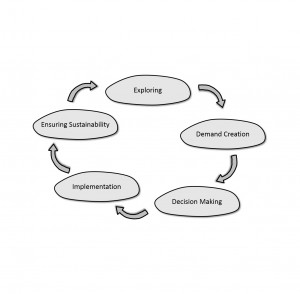Planning and implementing WASH interventions in Prolonged Encampments usually takes place during the “care and maintenance phase” of camps, where the focus for WASH interventions lies on upgrading and extending the existing facilities implemented during the emergency phase to ensure basic survival. The better the long-term sustainability was considered in immediate response plans, the easier it is for humanitarian actors in prolonged encampment settings to continuously maintain and upgrade services. This is why, according to the Linking Relief, Rehabilitation and Development (LRRD) concept, humanitarian aid, rehabilitation & reconstruction as well as development cooperation must always be streamlined when planning humanitarian interventions.
Unlike in camp settings, humanitarian actors in prolonged encampment settings face less time pressure for designing WASH interventions. On the down side, the available financial resources are often very limited due to declining donor support. For this reason, planning for WASH interventions in prolonged encampment settings must focus on cost-effectiveness, quality and durability of services.
The Sphere Project Core Standards describe the essential processes for achieving the Sphere minimum standards for humanitarian response. According to the Core Standards, a humanitarian response must ensure 1) a people centered, rights-based approach that takes into account people’s capacity in designing an appropriate response and 2) coordination and collaboration between all organisations and authorities to ensure maximum efficiency, coverage and effectiveness.
When aiming to achieve the core standards, the specific needs relating to the context, target group, existing capacities and stage of the crisis need to be taken into consideration. A full, informative and impartial WASH Needs Assessment is therefore fundamental for designing adequate intervention plans including overall objectives and planned activities. The level of detail depends on the stage of programme design. For example, the outline (or initial draft) programme design may simply state that communal latrines are to be provided, while the detailed programme design may describe the types of latrines proposed (see Core Standards 4 in the SPHERE Handbook for design and response).
In order to ensure that the planned humanitarian response continues to meet the needs, interventions should be adapted based on the outcomes of a continuous monitoring and evaluation as well as the impact on the affected populations (as stated in SPHERE Core Standard 5).
This module presents a number of participatory strategies, approaches and tools for effective and needs-based planning in Prolonged Encampments.
A review of water and sanitation provision in refugee camps in association with selected health and nutrition indicators – the need for integrated service provision
International Organization for Migration (IOM), Norwegian Refugee Council (NRC) and UN Refugee Agency (UNHCR)`s Camp Management Toolkit provide tools and approaches to provide concrete guidance on facilitating hygiene improvement in an acute, early stage of an emergency relevant to camps. This toolkit is applicable to both IDPs and refugees living in communal settings.
CRONIN, A. ; SHRESTHA, D. ; CORNIER, N. ; ABDALLA, F. ; EZARD, N. ; ARAMBURU, C. (2008): A review of water and sanitation provision in refugee camps in association with selected health and nutrition indicators – the need for integrated service provision. In: Journal of Water and Health: URL [Accessed: 26.10.2016]Water, Sanitation and Hygiene. Meeting the challenge of rapidly increasing humanitarian needs in WASH. DG ECHO Thematic Policy No.2
This thematic policy document provides information on meeting the challenges of rapidly increasing humanitarian needs. It provides information on basic principles of humanitarian response, emergency response and preparedness and response in acute, post-acute, protracted, and chronic crises, key determinants for interactions, guidance on coordination, advocacy, decision trees, and technical guidelines. It provides various insights on operations and maintenance planning for humanitarian crisis needs. The EC humanitarian WASH assistance follows the following objectives: 1) To ensure timely and dignified access to sufficient and safe WASH services for populations threatened by on-going, imminent or future humanitarian crises, and to increase their resilience to withstand water stress and shocks. 2) To implement measures to prevent the spread of WASH related diseases in populations threatened by on-going, imminent or future humanitarian crises. 3) To enhance the impact, relevance, efficiency and effectiveness in the delivery of WASH assistance by strengthening the capacities of the humanitarian aid system, including its coordination mechanism.
EUROPEAN COMMISSION (2014): Water, Sanitation and Hygiene. Meeting the challenge of rapidly increasing humanitarian needs in WASH. DG ECHO Thematic Policy No.2. Brussels: European Commission URL [Accessed: 31.10.2016]Humanitarian Charter and Minimum Standards in Humanitarian Response
The Sphere Project is an initiative to determine and promote standards by which the global community responds to the plight of people affected by desasters. This handbook contains a humanitarian charter, protection principles and core standards in four disciplines: Water, sanitation and hygiene; food security and nutrition; shelter, settlements and non-food items; and health action.
THE SPHERE PROJECT (2011): Humanitarian Charter and Minimum Standards in Humanitarian Response. Bourton on Dunsmore: Practcal Action Publishing URL [Accessed: 31.05.2019]Concept on LRRD Linking Relief, Rehabilitation and Development
This document establishes the frame of reference for the systematic incorporation of the LRRD approach into the Swiss Red Cross (SRC)’s humanitarian aid operations, its re-construction/rehabilitation activities and its development cooperation programmes, and supplements their specific strategic- conceptual foundations. The concept is the outcome of broadly supported SRC internal processes and provides SRC international cooperation staff with guidelines for planning and implementing the LRRD approach in programmes. It also serves as a basis for dialogue within the International Red Cross and Red Crescent Movement and with partner organisations, authorities and other interested institutions.
SWISS RED CROSS (2010): Concept on LRRD Linking Relief, Rehabilitation and Development. Bern: Swiss Red Cross URL [Accessed: 06.02.2017]

